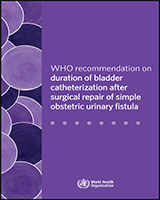1.1. Background
An obstetric fistula is an abnormal opening between a woman’s genital tract and her urinary tract and/or rectum caused by prolonged obstructed labour. Obstructed labour is associated with soft tissue ischaemia resulting from compression by the fetal head against the pelvic bones. When the mother’s pelvis is too narrow or the baby is too large or presenting in an abnormal position, labour can last several days and often results in the death of the baby and/or the mother. If the mother survives, she could develop a fistula and become unable to control her rectal and/or urinary functions and be constantly soiled and/or wet.
While obstetric fistula is a rare condition in high-income countries (1), in sub-Saharan Africa and South Asia prevalence is estimated at 1.6 and 1.2 per 1000 women, respectively (2). Most obstetric urinary (vesicovaginal) fistulae can be repaired surgically and the routine postoperative care of these patients involves the use of an indwelling urinary catheter to promote continuous urine drainage and to allow tension-free healing of the surgical scar (3). The duration of routine postoperative bladder catheterization is not standardized and varies widely in clinical practice, ranging from 5 to 42 days, with direct health and budgetary implications (4,5).
Long duration of bladder catheterization to allow complete healing can be inconvenient for the woman, her family and care providers. A long duration of bladder catheterization translates into the need for longer hospitalization in low-income countries, since these women cannot be managed as outpatients because of their catheter needs. Long bladder catheterization is also associated with more discomfort and inconvenience to patients, increased risk of infection and erosion related to catheterization, more intensive nursing care and more cost per patient (6). Shorter periods of postoperative bladder catheterization have been tested in simple cases of obstetric fistula and shown to be effective in allowing complete healing with improved patient comfort and potentially lower risks of catheter-related urinary tract infections (7).
The surgical repair of obstetric fistulae depends on the availability of operating rooms and adequate bed space for the recovery period, trained surgeons with specialized skills and, in many cases, funding from donors to support the operations and the postoperative care of these patients. In most contexts in low- and middle-income countries (LMICs), the need for fistula repair services far exceeds the available human and infrastructural capacity of the health system. A shorter duration of bladder catheterization would mean shorter hospital stays and consequently increased numbers of fistula patients who could be treated in existing facilities.
Evidence-based guidance on the duration of bladder catheterization after surgery can improve the health and well-being of women with fistula.
1.2. Rationale and objectives
Decisions related to fistula care are often based on the preferences of individual surgeons rather than on evidence from research, and despite the scarcity of evidence-based data on the management of fistula, there is a need to make formal recommendations about fistula care to improve women’s health and well-being.
As part of the World Health Organization’s (WHO’s) normative work on supporting evidence-informed policies and practices, the Department of Reproductive Health and Research has produced, as a first step, this guideline focused on the duration of bladder catheterization after the surgical repair of simple obstetric urinary fistula, as this is an intervention that can be implemented by any appropriately trained surgeon, including one with less experience, and it has direct health and cost implications in LMICs.
This guideline provides a foundation for the sustainable implementation of this intervention, which will help to alleviate the suffering of many women with simple obstetric urinary fistula.
1.3. Target audience
The primary target audience for this guideline is health-care professionals, particularly fistula surgeons and nurses providing postoperative care to women after surgery for obstetric urinary fistula. The guideline will also be useful to national and local policymakers, and staff of nongovernmental and other organizations involved in fistula care services.
1.4. Scope of the guideline
The population affected by this guideline includes women diagnosed with simple obstetric urinary fistula, a condition which is defined as a vesicovaginal fistula caused by obstructed labour. The guideline does not cover complex obstetric fistulae or those that do not have an obstetric cause.

